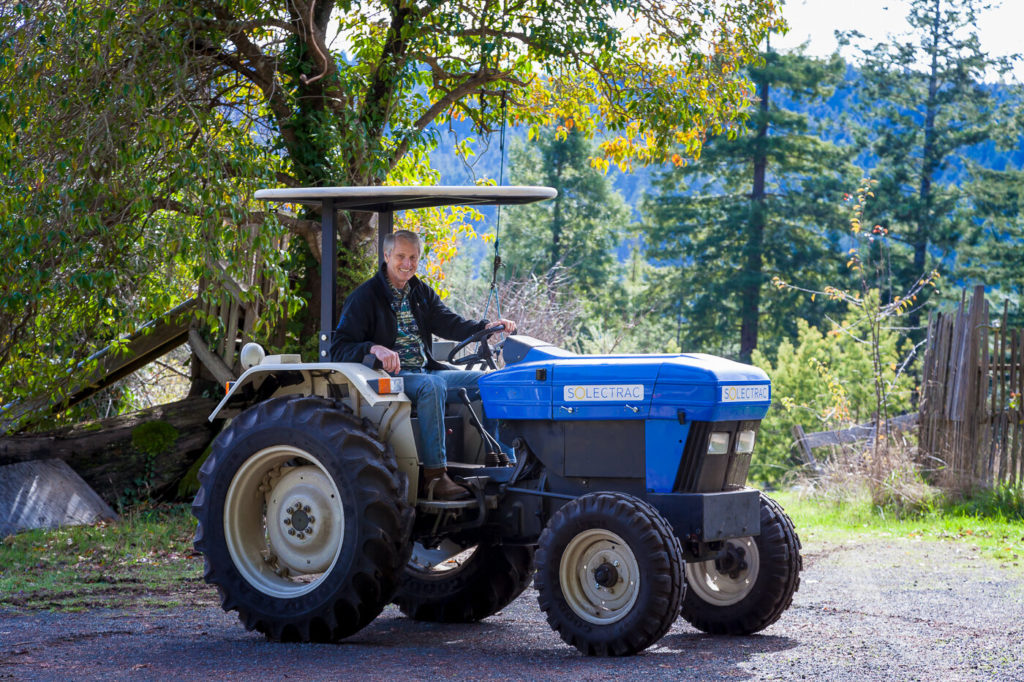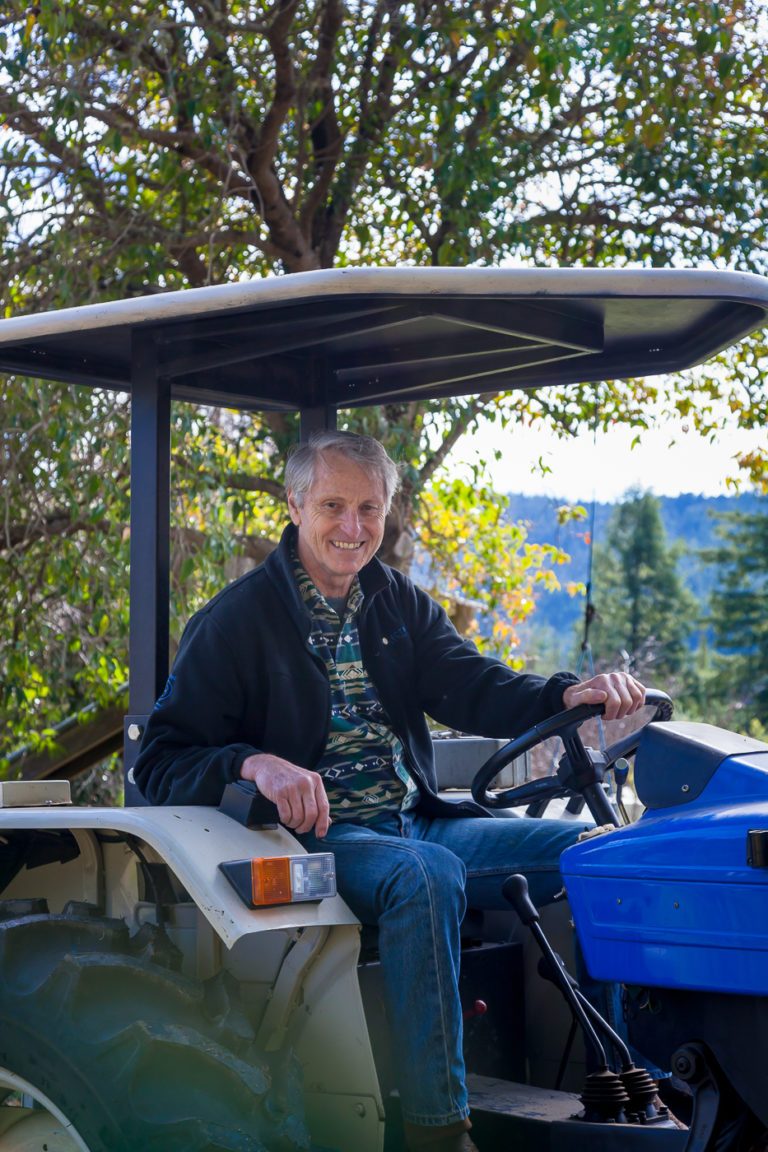
Local small business, Solectrac, a manufacturer of electric tractors based in Albion, CA, announced (June 2021) that they have been bought by global giant Ideanomics. This move will give Solectrac (now “Solectrac by Ideanomics”) access to resources that will provide the operational capital and business strategy necessary to become a global leader and supplier of clean agricultural equipment. Solectrac by Ideanomics will focus on building the business by expanding distribution, increasing inventory, strengthening and diversifying the supply chain, increasing production capacity, hiring seasoned leadership, growing the staff, and expanding sales and marketing reach within the US.
Who says dreams don’t come true? Read on to hear what Steve Heckeroth, founder and CEO of Solectrac has to say about his journey from dream to reality.

WC: Tell us about your background.
SH: I was born and raised in Southern California in the late ‘4s, early ’50s when it was the most polluted place in the world. Growing up, I learned that pollution was not a good thing. You couldn’t even see across the street sometimes because at that time there were no catalytic converters or exhaust control. This was where the auto industry first exploded and freeways happened. When I got to college, I participated in the first Earth Day in 1970 and decided to dedicate my life to finding fuel alternatives to burning fossil fuel.
WC: How did farming and tractors become your target?
SH: I wanted to get out of LA and so I went to school at Arizona State. In traveling back and forth, I decided on two places I wanted to live: Taos, New Mexico or Mendocino, California. I liked being near the ocean so Mendocino won out pretty easily. Back then, the back-to-the-land movement was just getting started and on this ridge (Navarro Ridge) there were four communes. I wanted to be part of that movement but I wanted to do it in a way that was sustainable so I could leave the planet in a better shape than I found it.
WC: How did you find your way to the electric motor idea?
SH: I started a business called Homestead Enterprises in 1975 and spent the first few years up here building furniture out of recycled wood and wood that I milled myself. Then I transitioned to gardening and growing all our own food. I taught at College of the Redwoods from 1974 to 1977; these were classes in alternative sources of energy and creating a self-sufficient homestead. In order to teach the classes I had to learn a lot, so I bought an old 1948 Ford tractor, which meant I learned a lot about maintenance! I decided there had to be a better way to do things so I stopped using the tractor and did the best I could with hand tools. I built terraced gardens and a storage pond for summer watering with gravity irrigation to the gardens. I started a company and sold solar water heaters and wind pumps , both of which go way back. Part of my business was also putting up water tanks and towers so people could have gravity feed water systems that didn’t require any energy except the wind.
WC: It sounds like you learned that you could get by without using motorized equipment. But what drew you to the idea of an electric tractor?
SH: What I say is that a good gardener can grow food for his family but if you give a good gardener a tractor, they can grow food for their whole community as there’s an increase in efficiency in the work that you can do. There were a lot of things that got me to the e-tractor. One of the first was I joined a group in 1972 to stop a nuclear power plant in Point Arena. They had already started digging the foundation for the plant so we hired a geologist who examined the foundation and found an earthquake fault and that stopped that project. In the late ’80s I started building electric cars but realised one of the big issues with the lead acid batteries (which was all that was available back then) was their weight. It was around this time that I went to the county fair where there was a tractor with a big cement block on the back to balance the weight of the forklift on the front. The lightbulb went off, tractors need weight but you can have smart weight, not just dumb weight. So I switched my focus to tractors and for the past 31 years or so that’s what I’ve been working on: trying to make an electric tractor that would do everything a diesel tractor does except without pollution or noise. There are so many advantages: an electric motor has one moving part, a diesel engine has 300 or 400 moving parts that all have to be lubricated and maintained. And with the new emissions controls, the maintenance issues on tractors are just out of control.
WC: How did you figure out how take your idea for a solar-powered electric tractor from a dream to reality
SH: I was educated as architect and when I moved up here, among other things, I started building passive solar homes. I actually built a house on Caspar Point that won many awards because it didn’t require any energy except the sun. And that was before there were photovoltaic cells! I heard about a company that was making thin-film solar, which is an ideal product for roofing because you can make the roof out of the solar panel. They were making panels but I had them make the product in long rolls and developed a method to apply it to the roof. Stan Oshinsky (who owned the company) called me and invited me to Michigan where I learned a heck of a lot about solar and the whole solar industry. This experience enabled me to think about making electric vehicles that could be totally disconnected from the grid and fossil fuels. Solar is a leveling agent for change because if a country has fossil fuels, it’s rich and it it doesn’t, it’s poor. This all led me to the idea of an electric tractor that’s powered by the sun. Think about this: you can have a container for the tractor with a foldout solar array, put that down anywhere in the world and the tractor will be ready for farming the next day. And if you have an inverter on that tractor and exchangeable battery packs, you could use it as a mobile power source to power disaster areas or schools, clinics, homes. The outcome is that you have a mobile power source, a tractor that can increase the efficiency of your work 20 to 50 times over.
WC: How will this electric tractor benefit farmers?
SH: There are about 600 million farms in the world but only about 25 million tractors so 95% of the world’s farms don’t have tractors. We need to get away from the huge farms with gigantic equipment that produce mono-crops that use incredible amounts of energy both on the input and output side. We have to return to community scale where the farmer feeds his local community and people can walk to where they get their food. We have to localize our food production and that’s one of the reasons I started building small solar tractors.
WC: There are practical things that you need to deal with as well, like having a bank account, tires for the tractor. How do you reconcile those practical aspects with your dream of a world that’s not reliant on fossil fuels?
SH: That’s a big question. The dream is that everyone is on the same level playing field and the sun does that for us. With photovoltaics, everyone has the same access to the sun, the same ability to gather the energy that they need. The practical parts of that are more difficult. When I first started building e-tractors I was converting old tractors that have gears. Modern tractors use hydrostatic drives, which elimate gear grinding but have about half the efficiency of tractors with gears. I couldn’t find any new tractors with gears so I had to go to India to find a company. I was able to buy brand new old-style tractors and shipped the parts here. After I started the relationship, they asked me to build them a prototype electric tractor. We shipped it over to them and two years later they came out with a compact electric tractor of their own. They’re the first manufacturer of electric tractors and we’re the exclusive distributor of that tractor in Canada and most of North America.
WC: What’s it like to have a dream for so long and finally see it come to fruition?
SH: It’s funny–people say to me “You’re doing this at just the right time!” And I say, “yes, it’s taken me more than 30 years!” It’s amazing but it’s also an awesome responsibility because to turn an idea into an industry isn’t really what I’m cut out for. I’m a designer and I love designing things so I’m trying to surround myself with people who can cover different aspects of what needs to be done to turn this thing in my shop where we build one tractor a month into a place that can assemble 100 or more tractors per week.
WC: When you needed expert help, who did you turn to?
SH: Throughout this process of growing Solectrac to what it is today, I relied on the Mendocino SBDC and West Center to guide me to different sources of information. They have experts in every area: finance, for example, which is really critical. Crowdfunding, which West Center helped us with, raised more than a million dollars for us and got our name out there.
WC: What was your experience working with West Center?
SH: I spoke with an advisor over the phone and he said to come into the office. He was as excited as I was about my ideas. It was reinforcing to speak with someone who had the contacts that I needed to grow the company: contacts in marketing, HR, finance, investments, all kinds of things that are needed that I had no clue about. The advisor suggested several people in each specialty area and I’d interview them to see who was most aligned with what I wanted to do, which is really important to me. West Center introduced me to a number of people, particularly in marketing, who were experts in their field and they helped get our name out, which had been a huge problem. I found someone who knew about B-Corps who helped me get a corporation set up and is now our COO. It was essential to have those connections and continue to rely on the Mendcino SBDC as I reached each new level of development.
WC: What would you tell someone who has their own dream for a business?
SH: If you’ve got an idea for a really great company or product but you don’t have a clue about business, West Center is the ideal place to go because they will give you free information and guide you to people who will make your dream or product a reality. It’s an incredible service.
WC: Has your dream come true?
SH: I still think I have a long ways to go! I’m trying to replace myself so I can get back to development. I want to scale down. I want people to have jobs that are meaningful. For more than 12,000 years, one of the most meaningful jobs was to grow food. Agriculture is what makes things happen! As Paul McCready said, “150 years ago, 98% of the people in the US worked on farms or had something to do with agriculture; today only 2% are involved with growing food.” People have lost touch with the soil. The oceans and marine life are in trouble and so we’re going to have to rely on the land for producing more food. So that’s another reason to get these tractors into the hands of people around the world.
WC: Are we, as a human race, going to succeed?
SH: I think we’re learning a lot of lessons from the pandemic. The main one is how dependent we are on each other. To be isolated for any length of time and you lose your humanity. Growing food, working together in the garden, having your hands in the soil gives us humanity. Agriculture is in our genes. We have to return to the natural cycles that we’ve disrupted. I think most people are starting to realise that we need some major changes and go to a solar economy that will not continue to pollute the earth and cause greenhouse gas emissions and climate change.
We left Steve tinkering in his workshop on a south-facing ridge on the beautiful Mendocino coast but before we departed, we asked him for some parting words: “It’s a beautiful sunny day but it was supposed to rain. I think we’re on the right side of history.”


